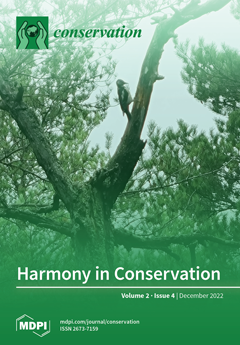Biodiversity assessment is important for evaluating community conservation status. The
haor basin in Sylhet Division represents a transitional zone with high species availability, rare occurrences and endemism. As a result, this study aims to describe the
haor-based freshwater fish composition, including habitat,
[...] Read more.
Biodiversity assessment is important for evaluating community conservation status. The
haor basin in Sylhet Division represents a transitional zone with high species availability, rare occurrences and endemism. As a result, this study aims to describe the
haor-based freshwater fish composition, including habitat, trophic ecology, availability and conservation status. Semi-structured questionnaires were used to collect data on fish samples through focus group discussions, field surveys, and interviews with fisheries stakeholders on a monthly basis. We identified 188 morpho-species, of which 176 were finfish and 12 shellfish, distributed into 15 orders and 42 families where 29%, 42%, 15%, and 14% species were commonly available, moderately available, abundantly available, and rarely available, respectively. Cypriniformes was the dominant order in both total species and small indigenous species identified. Approximately 45.34% of species were riverine, 31.58% floodplain residents, 12.55% estuarine, 2.83% migratory, and 7.69% were exclusively hill stream residents. Carnivores and omnivores were the most dominant trophic groups. A total of 87.76% species were used as food, 12.23% as ornamental and 6.91% as sport fish. Approximately 50 species were threatened (7 critically endangered, 23 endangered and 20 vulnerable) at the national level, most of them belonging to Cypriniformes and Siluriformes. Based on endemism, 16 species were endemic of which Sygnathidae, Cobitidae, Olyridae, Cyprinidae and Balitoridae fell under the threatened category. Minimizing intense fishing efforts, banning indiscriminate fishing and destructive fishing gear, initiating fish sanctuaries and
beel nurseries, and implementing eco-friendly modern fishing technology are suggested to conserve the threatened species. This study represents a guideline for assessing the availability and conservation of freshwater fish in the Sylhet belt and serves as a reference for decision-makers in order to allow for the sustainable exploitation of fisheries resources within an ecosystem-based framework.
Full article





